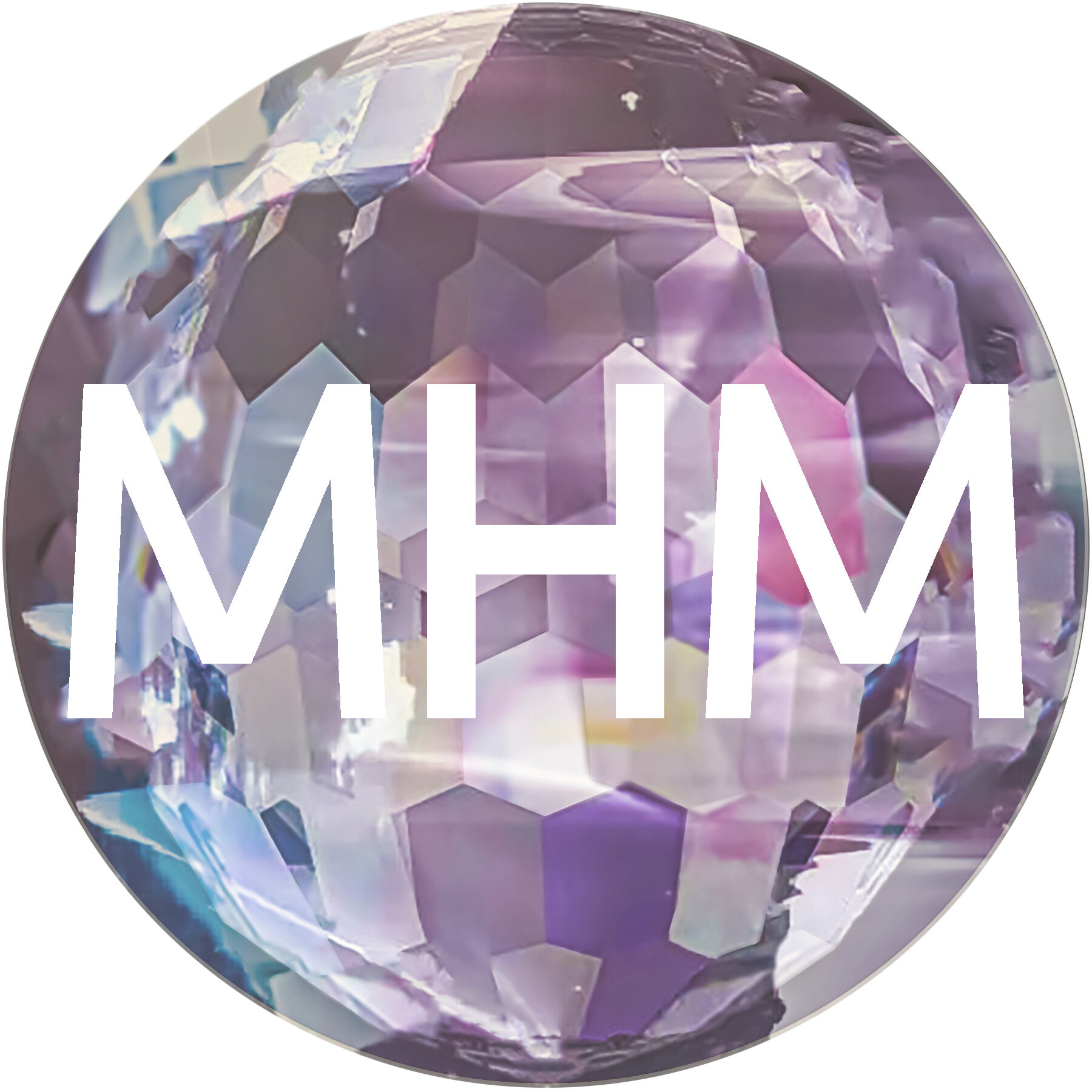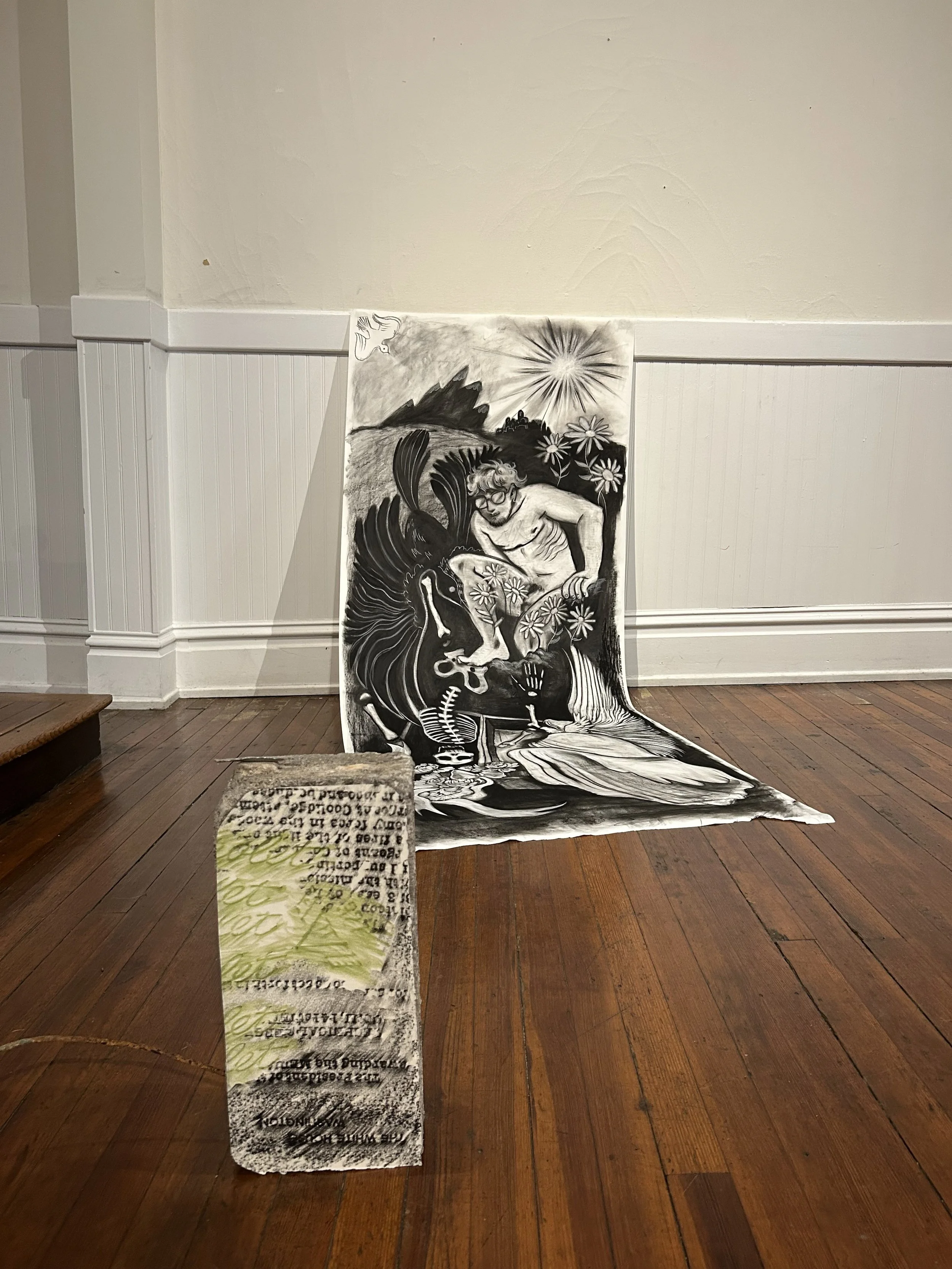Capricornus: A two-person show by Jules Jackson and Emily Rice.
Capricornus
A two-person show by Jules Jackson and Emily Rice.
exhibition review and interview by Kate Greenwell
Capricornus is a two-person show by Jules Jackson and Emily Rice. The Show is located within a church turned studio space that has personally helped me build my own practice. I was able to participate in the Union Ave. Residency at St. Andrew’s last year. The six months working within that studio space was an amazing opportunity for me to grow my practice in between undergraduate and my master’s program, and I am very grateful to Jules Jackson, Terry Davis, and Will Sutton for starting the amazing low-residency program.
The St. Andrews center was the perfect background for Rice and Jackson’s work. Jackson’s work, large scale charcoal drawings, communicated with the space, laying across the original wooden floors of the rounded room. The installation of the drawings sprawled across the ground instead of a traditional wall install helped to move the audience around the room, eyes exploring up to Rice's found object sculptures. The best moment in the show for me was an extension of Rice's sculpture above Jackson’s floored drawing. The sculpture arcs over the top of the drawing, shadow casting a wing shape directly on top of Jackson’s drawing of an angel. The two practices meet perfectly in this scene, Rice's sculpture creating a physical presence cast on the angel, protecting and grounding the rest of Jackson’s drawing as it extends down into the well lit landscape of the room.
Jules Jackson and Emily Rice, “Here” mixed media, 2025
Interview with Jules and Emily…
KG: As a Capricorn I need to know: What was the importance of the show title: Capricornus?
ER: I believe the title Capricornus almost chose itself. Back in 2024, Jules and I were chatting during a studio break, and we established a desire to share our practices together. We knew that we might be relocating in the fall of 2025, so it felt more urgent to share our works out of the St. Andrews Center with haste.
We made plans to exhibit in early 2025, even posing the exhibition as a birthday party for the end of January. I was offered a position earlier than anticipated, so a pin was put in the show until we could be together again.
Plans for Capricornus resumed when I returned to Chattanooga for the summer. The show maintained its position as a celebration of our shared birth month, falling around our half birthdays and the Full Buck Moon in Capricorn. Like the Capricorn sign of the zodiac, our work navigates physical and emotional realms. I enjoy picturing our works forming a type southern constellation to reflect upon the Appalachian land, undulating rivers, and folks found here.
JJ: Yes! As Emily said, “Capricornus” as a title came to us because we share a birth month of January, so we wanted to celebrate that as an aspect of our friendship. We did plan it originally for January of 2025, but ended up pushing it to the end of summer. I feel like it was better this way because it marked our shared departure time from Chattanooga, directly after the show Emily went back to Texas to teach, and I moved to Boulder, CO to begin my MFA program in painting and drawing.
KG: Emily, there's an importance in the collected and found object in your practice, and it seems like the collection is formed by your time in Appalachia, I’m seeing a lot of scrap material, a nod to construction and a nod to a changing south. Do you resonate with any of that?
ER: My family moved to Chattanooga when I was a child, and I stayed here until leaving for college in Birmingham. I later returned to Tennessee, living in Knoxville for my master’s program.
Birmingham, Chattanooga, and Knoxville are all considered to be a part of the Appalachian region. Though proximally close, these cities are a good look into the diversity of life in Appalachia with its varying industries, terrains, critters, and socio-political climates.
Appalachia has absolutely raised me. Due to its convoluted nature and ill-perceptions by many not from here, I have often found myself wanting to come to its defense. My work, in its own way, addresses this. I want so much more for this place and for the life within it to not be dismissed.
Material collection and connection inform how my sculptural drawings are resolved. Whether walking through neighborhoods, hiking in the woods, or scrambling over a demolition site, I am picking up objects that grasp my attention. My pockets and bags are filled with trinkets, frottages of observed textures are piled, and heavier materials are stacked in my car and studio.
I clean and arrange objects, seeking material relationships from one object to the next that might share a story. This method is rooted in material agency and my efforts towards deanthropocentrism. I believe in the life behind all materials and am deeply curious about their origin stories as well as who or what might have handled them along the way.
KG: Jules, continuing on with the Appalachia question, as someone born and raised here and I know you are as well, I see a few references to religion in your large scale drawings, a scene of a dove extending protection, the mention of a heaven. Religion is a struggle that a lot of younger members of the south cope with; can we still achieve our own kind of heaven and how do you seek that in your practice?
JJ: We can absolutely achieve our own kind of heaven. Heaven is spending time with the people you love and who love you. Heaven is being on the banks of Suck Creek on a hot Tennessee summer day. Paradise exists in little pockets of everyday life.
Religion is a huge part of growing up in the South no matter how you were personally raised because it’s an unavoidable part of our visual culture. Everywhere you go, you can’t help but see religious symbols and messages. You run into these cryptic and surreal messages on billboards, literature, everywhere. It’s just a part of the cultural landscape.
KG: How do you feel the combination of your practices has changed your work and defined your connection in creating this show? I know Jules’ works more personally and this show encapsulates a removal from his normal painting practice. Emily, has working with Jules changed your perspective on your practice at all?
JJ: Getting to create this show with Emily definitely led me to see my own work in a different context! Emily has a very different material approach to drawing than I do, but we share an interest in drawing. You could describe this show as predominantly a drawing exhibition.
Their work also deals with the materials and culture of southeast Tennessee, in a different way than mine does. They use organic and inorganic materials directly found from specific sites. In my drawings (and sometimes my paintings too), I poach symbols, phrases, and characters from southern visual culture. Both of us appropriate certain materials or images and recontextualize them or remake them. It’s interesting to exhibit with a friend whose work looks so different from mine but deals with so many of the same ideas.
ER: It is truly an honor to be invited into the process by an artist and friend I admire so much. While piecing together our show, some parts took months whereas others came together quite quickly. Working with Jules this closely has allowed me to see a different perspective on managing the time I give to making in the studio. I deeply appreciate seeing how he can shift and intensify focus and direction.
Jules is an extremely busy person, navigating a schedule around his work life, school, family, friends, community care, fitness, and practice. He is truly a man on the go. At a party, he is in the middle of it, dancing to Lady Gaga or telling a story that will leave you ready for the next chapter.
Collaboration is something I lean into, so I was excited to learn how much Jules plays with placement. He showed me that even if two sets of hands do not go into the same piece, proximity of the works can shift a viewers’ understanding to be much more expansive. Works begin to converse, like two friends sharing a table at Niedlov’s, gossiping over coffee and pastries.
KG: And finally, How do you get to heaven from Chattanooga Tennessee?
ER: It’s probably on the other side of a compost pile my pops visits every week. He likes to send photos of its mycelium network to the family group chat. His soil evangelism points to a certain type of heaven that feels really good.
JJ: I really think it has something to do with the creek. I had an experience last year at a certain point in the creek where I really believe that I passed through a veil of some kind between spiritual planes. The exact location is a secret.
KG: Thank you guys so much for sharing the thoughts behind your work. Is there anything else you’d like to share before we end? Any upcoming news or opportunities we should look forward to?
ER: I recently learned that I have been invited for a residency at Stove Works next summer. Having met so many incredible artists, makers, curators, musicians, writers, and birders who have come through Stove Works, I am beyond honored and excited for this opportunity and to further deepen my practice in my hometown!
Also, I’m starting another garden, so I’ll let you know how that goes.
JJ: I am having a solo exhibition in Findlay, Ohio at the Neon Heater in April 2026! If anyone is in the area, please join us for a new exhibition in another part of Appalachia.
KG: Amazing guys, thank you so much and congratulations!








